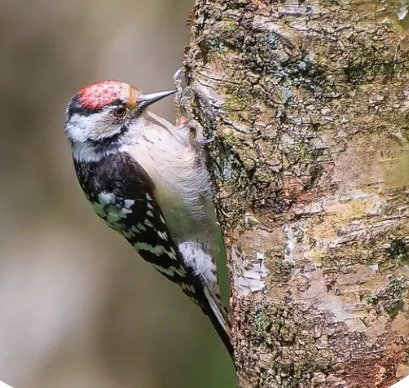
Canada and America are filled with many wonderful birds with brown wings – in fact, there are 22 birds that you can spot. Have you spotted a bird with brown wings that you’re looking to identify? Look no further than this article.
This article will list all 22 birds and help birdwatchers find and identify all birds of North America that have brown wings with both pictures and calls.
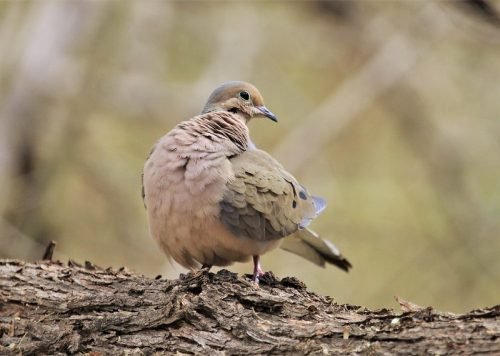
Mourning Doves were named for the mournful sound of their owl-like cooing.
They’re plump-bodied songbirds with small heads and long tails, dressed in shades of soft brown. A 12″ measurement from beak to tail tip makes them considerably bigger than the average backyard bird. It has a short, straight bill and a long, pointed tail.
The Mourning Dove is the only summer songbird that doesn’t eat bugs, spiders, or other creepy crawlies. Their diet consists almost entirely of grains, as well as the seeds of various weeds, grasses, and herbs.
They also like to snack on berries and snails now and then.
The mourning dove is native to the Americas, primarily populating the northern parts of North and Central America, with a few scattered populations in northern South America.
These birds can be found in a massive 11,000,000 km2 of territory, which includes all 50 of the United States, most of Mexico, the Caribbean and Greater Antilles, Costa Rica, Panama, and other Central American countries.
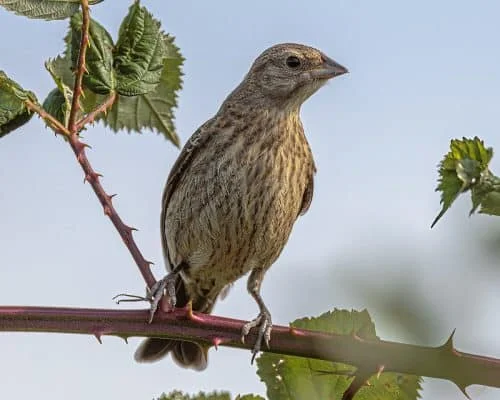
One of the hardest brown birds to identify in the United States is the female brown-headed cowbird.
The best field marks for recognizing them are the short, thick, and pointed black bill that ends at a flat forehead, as well as their general appearance of being simple and drab grayish brown.
Their diet consists mainly of fruit and nuts. They eat spiders, arthropods like grasshoppers and leafhoppers, and insects like beetles, as well as eggs.
During the mating season, females would eat mollusk shells to boost their diet.
The brown-headed cowbird is native to much of North America, including the United States, Canada, and Mexico.
In the southern portions of their area, they are permanent residents, but during the winter, the birds that live in the northern sections of their range migrate to Mexico and the southern regions of the United States.
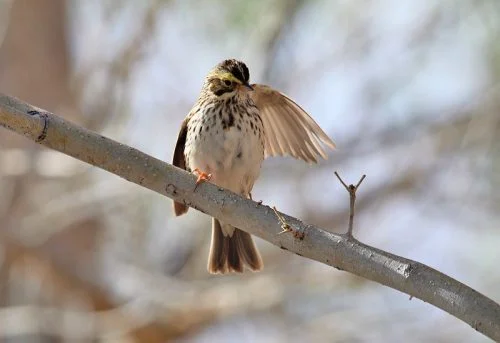
The Savannah Sparrow is the most common open-country streak-breasted sparrow in Washington, but it varies greatly over its range.
This species has a brown back with dark streaks and a white belly with brown or blackish streaking on the breast and flanks. This brown sparrow has a characteristic yellow spot by the eye, which may be seen if you get close enough. They have stubby tails and a patchy brown appearance.
Seeds and insects make up the Savannah Sparrow’s diet.
During the breeding season, these sparrows increase their insect intake to provide food for their young. The majority of the diet in the fall and winter consists of seeds and berries. Coastal communities also eat small crabs and mollusks.
They are primarily medium-distance migrants, though there are also permanent populations along the coasts of California and Mexico.
They can be seen returning to their spring mating areas anywhere from late February in Kentucky to early May in Alaska. They begin their journey to their winter range between the middle of September and early November.
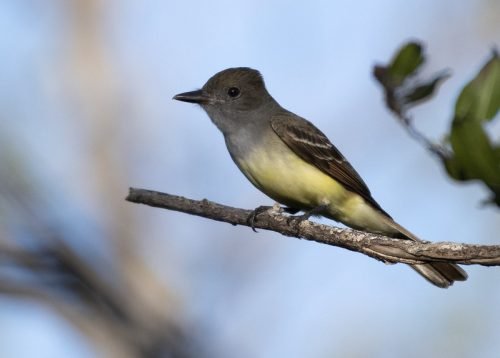
The great crested flycatcher, with its large crest and refined mating call, is a beautiful and intriguing species of bird. It’s usually easier to hear than see because of all the trees and vegetation in the way.
Great Crested Flycatchers are reddish brown on top, with a brownish-gray head, gray neck, and breast, and a bright lemon-yellow belly. The brown upper parts stand out because the primary and secondary flight feathers flash a rusty orange color.
Although they may eat a wide variety of foods, their common name gives away their major diet.
These birds are primarily insectivorous, eating things like flies, insects, and caterpillars.
The Great Crested Flycatcher breeds widely across the middle and eastern United States and southern Canada and then migrates to warmer climates in the southern hemisphere for the winter.
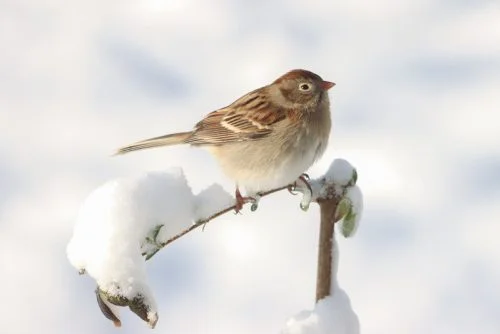
The little, slender, brown-backed, black-spotted birds known as field sparrows. Their bellies and heads are gray, while their scarlet crowns and pink bills set them apart.
This little bird is a member of the New World sparrow family, Passerellidae. It is over 140 mm in length and tips the scales at around 12.5 g.
In the winter, their diet consists of more than 90 percent seeds, mostly the tiny seeds of grasses. The summer diet consists primarily of insects, while grass seeds are also a major component.
The field sparrow is found in eastern North America, including eastern Canada and the eastern United States, with northern populations migrating to the southern United States and Mexico each autumn.
During the breeding season, males can be easily spotted since they sing from a perch first thing in the morning.
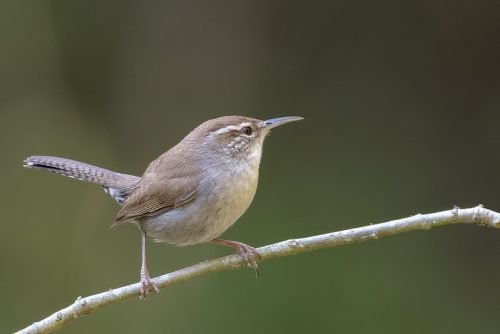
You may have seen a Bewick’s Wren if you come across a loud, frantic little bird with prominent white eyebrows and a long tail that it flicks as it leaps from branch to branch.
The long, upright tails of the Bewick’s Wren are complemented by its brown back. A white stripe runs across each of their eyes, and their bellies are gray.
They feed primarily on insects.
They forage for insects and insect eggs in plants, even on tree trunks. They prefer to forage on the ground rather than in the low foliage (up to around 3 meters) that is more accessible to them. When foraging, Bewick’s wrens can hang upside down to get insects on the underside of a limb.
The Bewick’s Wren breeds from southwestern British Columbia to southern Mexico, and it also breeds locally in the eastern United States, though this is much less common.
There have been numerous sightings of this species in Montana over the past decade.
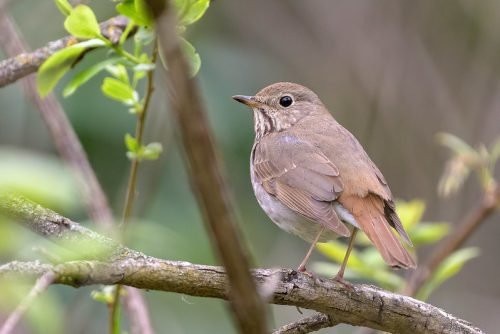
The hermit thrush is a shy little songbird that spends the summer in the underbrush of northern forests and winters across much of North America’s southern half.
The rich brown upper body, smudged dots on the breast, and reddish tail of this bird easily set it apart from other members of its genus.
The food of a Hermit Thrush will change with the seasons.
In the spring, their diet consists primarily of insects, including bees, wasps, flies, and caterpillars, with the occasional tiny amphibian or reptile thrown in for variety. Similar to another tough visitor, the Yellow-rumped Warbler, they rely primarily on fruit, especially berries, for food during the winter.
It’s the only species of spot-breasted thrush that spends the winter months in the United States.
Most Hermit Thrushes spend the winter in the southwestern United States, Mexico, or even as far south as Guatemala, except for those that live along the West Coast up to southern British Columbia.
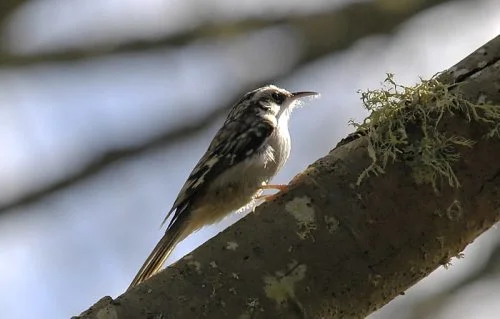
Brown creepers are tiny birds that seem like a piece of bark from a few feet away. They have a dark brown body, a dark brown head, and a lot of white splotches and streaks on their wings. They feature what seems to be an eyebrow-shaped white stripe over their dark eyes.
They mostly eat small arthropods such as spiders, pseudoscorpions, and insects. Some of the insects they eat are stinkbugs, fruit flies, and weevils. They also eat seeds and other plant parts during the winter.
Brown creepers are the only species of treecreepers in North America. They range from the northern tip of Nicaragua south to the southern tip of Canada and Alaska.
The brown creeper population that breeds in the southern half of its range remains permanently settled in that location. During the winter, the range’s northernmost breeders head south.
Aside from the mountains, the Great Basin, the Sonoran Desert, southern Texas, and Florida, brown creepers can be found everywhere in the United States in the winter.
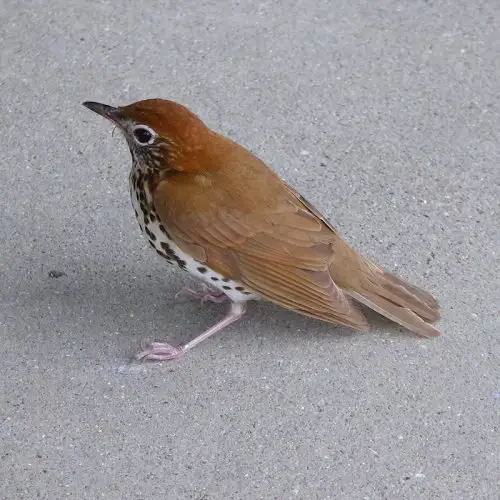
The wood thrushes are little birds that only measure 19 to 21 cm in length and weigh 40 to 50 g.
Wood Thrushes have a warm, reddish brown top and a white underside with bold black dots. To a lesser extent, this trend is also seen in juveniles. All of them feature a pronounced white eyering.
The omnivorous wood thrushes prefer to eat soil invertebrates and larvae but will also consume fruits in the late summer, fall, and late winter. They occasionally eat small salamanders, snails, and arboreal insects.
Wood thrushes switch from eating insects to high-lipid fruits during the post-breeding and pre-migration periods.
To achieve their daily metabolic requirements, the birds must continuously feed on insects during the summer due to poor fruit consumption and low lipid reserves.
In the eastern United States, the Wood Thrush breeds in deciduous and mixed forests where there are big trees, a moderate understory, shade, and lots of leaf litter for feeding. They spend the winter in lowland tropical woods in Central America.
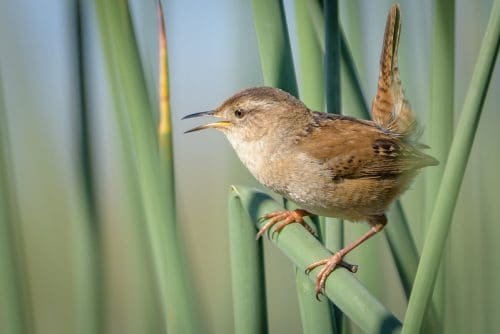
The marsh wren is a small North American songbird of the wren family. To differentiate it from the sedge wren, which has a shorter beak, this bird is also referred to as the long-billed marsh wren.
The adult has a brown back and head, a lighter brown underside and sides, and a white throat and chest.
The back is black with white stripes. Their short, thin bills and dark caps set them apart.
These birds actively feed on insects that are flying overhead while foraging in the grass near the lake.
They eat mostly insects, but also spiders, snails, and other arthropods.
They can be found across North America in places with thick vegetation, like cattails in the marshes where they lay their eggs. Some bird species live in the west of the United States year-round. Marshes and salt marshes in the southern United States and Mexico are popular destinations for migrating birds.
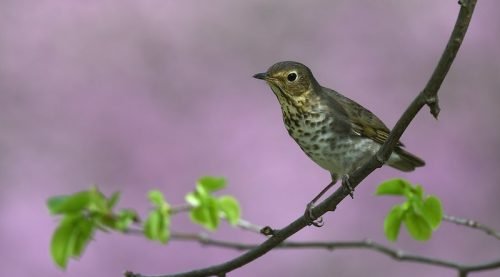
Swainson’s thrush can be distinguished from other thrushes by its light, buffy eyering, and face. Every part of the upper body, from the head to the tail, is a uniform medium brown. Like other members of the genus Catharus, it has a subdued color scheme and a lovely, ascending flute-like voice.
They forage on the forest floor and also in trees. Swainson’s thrushes mainly consume insects, fruits, and berries.
They construct a cup nest on a tree’s horizontal branch.
During the summer, look for the Swainson’s thrush and its distinctive, swirling song in the dense forests of northern North America and the West.
Swainson’s thrushes become numerous across most of wooded North America during migration in spring and fall. Though these birds can be hard to notice on the ground in a thick woodland understory, they sing often in the summer and call frequently throughout the migration.
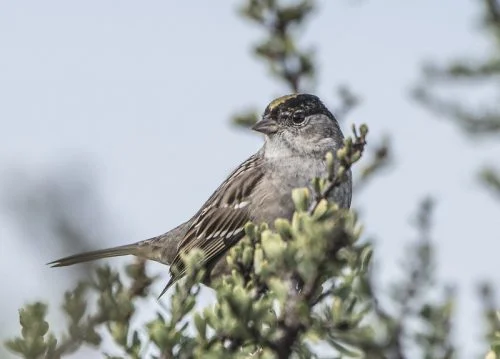
The Golden-crowned Sparrow’s breeding plumage is vibrant, with a bright yellow crown flanked by bold, black bars. It has bright stripes over a light brown back. The long tail is the same brownish-gray as the unspotted back.
The golden-crowned sparrow, like other members of the genus Zonotrichia, is mostly a ground feeder.
At times, it will even take to the air in pursuit of insects, or it may glean them from nearby plants. It heavily relies on a diet of seeds, berries, flowers, and buds, with the occasional crawling insect as a supplement, particularly in the colder months.
Across the western half of North America, you may easily spot the golden-crowned sparrow.
It’s a migratory bird that spends its summers along the coasts of southern Alaska and northern Baja California and spends its winters nesting in the forests of the Yukon and Washington.

Song Sparrow is a medium-sized bird with a comparatively large body. The bill is short and thick, and the head is somewhat spherical, making this bird look like a sparrow. The wings are wide, and the tail is long and rounded.
They have a white chest and flanks with brown streaks that are sometimes rather thick. As one gets closer, one may see that the head is an alluring blend of warm red-brown and slender gray.
The song sparrow is mostly a ground feeder, and it may even scratch the ground in search of its preferred meals. Mostly it subsists on insects and seeds. Beetles, grasshoppers, wasps, spiders, and ants are just a few of the many insect species that make up its diet.
All of North America is home to song sparrows, from Alaska to Florida. Birds from the northern area of their range travel south to the southern United States or Mexico for the winter, but populations in the southern half of their range do not migrate at all.
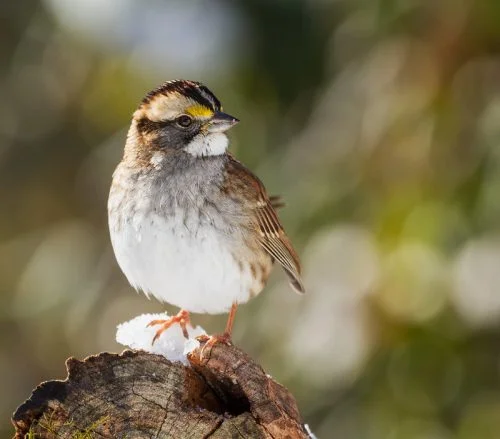
White-throated sparrows are little songbirds that belong to the Passerellidae family in the New World. Its body length ranges from 15 to 19 cm, and its wing spread is 23 cm.
The White-throated Sparrow population is divided into two distinct color morphs: those with white stripes and those with tan stripes. The backs of both species are striped brown, while the undersides, as well as the rump and tail, are a distinct grayish brown.
Small seeds and berries make up the bulk of the White-throated Sparrow’s diet throughout the winter period of the year.
During the summer, a sparrow’s diet shifts to focus more heavily on insects, yet it still includes leafy greens and berries.
This species travels south and east to spend the winter. Since the females go further than the males do, there are more females to be found at more southern points of the Atlantic flyway. In Canada’s Atlantic provinces, it remains persistent throughout the year.
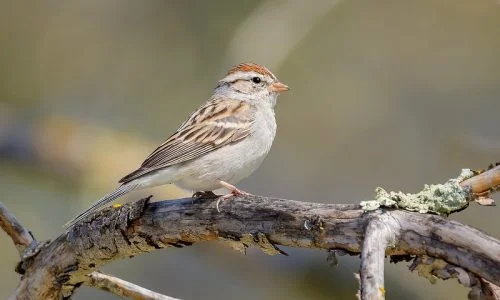
The chipping sparrow has a notch in its tail and a unique rusty cap during mating season, the Chipping Sparrow is easily identifiable. The wings are striped with two white bands, and the underside and tail are gray. Its head and back are streaked with brown and black, but there is a distinct gray band at the nape of its neck.
The Chipping Sparrow largely relies on seeds as its primary food source, particularly in the cooler months of the year.
They also consume several crawling insects throughout the breeding season.
Chipping Sparrow spend the entire year in the southern United States and the Central American mountains. Birds that breed in northern Baja California, Mexico, and Florida migrate south to Baja California, Arkansas, and Tennessee.
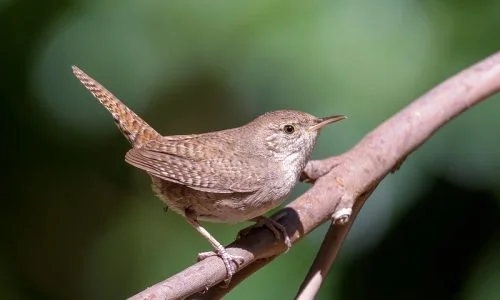
A little, brown bird with few distinguishing features, the House Wren is easy to overlook. Its overall coloring is lighter than that of the Winter Wren, and its tail is longer. Its back and belly are relatively clean, but its wings and tail are speckled.
It’s a shy bird that bounces around on the ground and in the low understory, holding its short tail high. Its own and other nesting birds’ eggs are frequently damaged by its sharp beak.
House Wrens eat mostly bugs and spiders that move around on the ground.
It has a breeding range that covers the whole southern half of the American continent, from Canada to the southernmost tip of South America via the West Indies and Central America.
A majority of House Wrens spend the winter in the southern United States or northern and central Mexico.
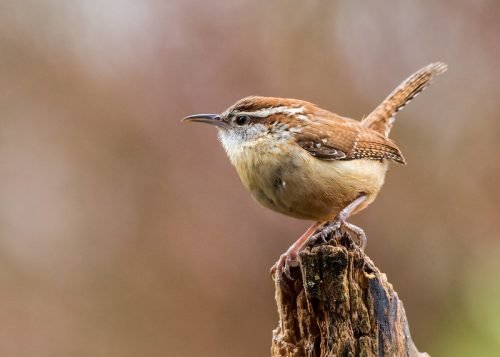
The Carolina Wren is the largest wren species found in eastern North America. They’re 12–14 centimeters long and weigh around 20 grams. The underside of a Carolina wren is a lighter cinnamon color, while its back is a rusty brown.
It has a white throat and chin, brown wings and tail, and very fine black stripes.
Insects make up the bulk of the diet of a Carolina wren.
They consume a wide variety of bugs and spiders. Insects and spiders are their primary food sources, and they tend to devour whatever they can find on the ground.
To find food, Carolina wrens use their bills to search through brush and foliage, looking beneath brush piles, in decaying logs and trees, and around the margins of marshes. Carolina wrens live in the southeastern United States all year.
Their range extends from the Atlantic coast to as far west as Texas, Nebraska, Kansas, and eastern Oklahoma. Southern Michigan, New York, Massachusetts, and Ontario, Canada, are the northernmost locations where they have been documented.
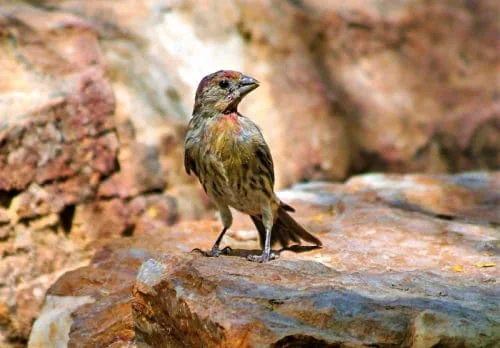
This is a moderate-sized finch. The length of an adult bird is between 12.5 and 15 centimeters (5 and 6 inches), and its wing span is between 20 and 25 centimeters. The females are a dull gray-brown color overall, with unremarkable features and streaky appearances on their bellies.
In their natural habitat, house finches will forage on the ground or among low foliage.
They ingest weed seeds like nettle and dandelion with the same fervor that they do grains, seeds, and berries.
The house finch can be found from southern Canada to northern Florida and southern Mexico.
It prefers the warmer climate of the East, where it can be found among buildings and dwarf conifers in suburban and urban settings. Western locations include deserts, savannas, riparian zones, and open coniferous woods.
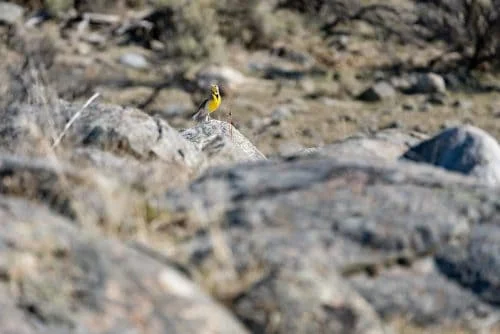
Female Rose-breasted Grosbeaks are stunning in appearance. Its head and upper body are light brown, and it has light breasts and a distinctive rose-pink patch on its throat and upper breast. a distinctive rose-pink patch on her throat and upper breast.
Her tail is also short, and her bill is pointed. Males are slightly larger than females, but otherwise, the sexes look identical.
Rose-breasted grosbeaks feed on insects, seeds, berries, flying insects, and nectar when foraging in shrubs and trees. It prefers to stay high in the trees and is only occasionally spotted close to the ground.
During the winter, fruit like Trophies racemosa can attract them to parks, gardens, and even bird feeders.
Rose-breasted Grosbeaks are native to North America and can be found in a wide range of environments, from forests to parks.
Although they are more prevalent in the east, you can also find them in the west, particularly in the Rocky Mountains and the Pacific Northwest. They breed across much of their area but are most widespread in the eastern section of their range.
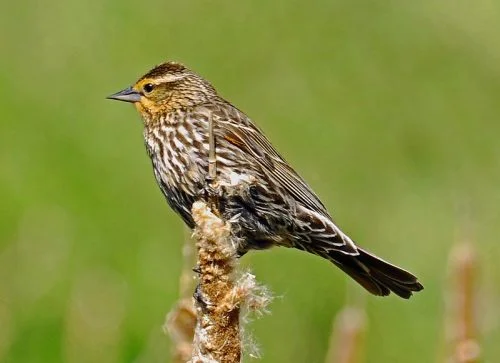
The female red-winged blackbird lacks the vivid color of its male counterpart. They have a little red patch on their shoulder and are otherwise brown with some streaking markings on the breast.
Females are noticeably smaller than males, with a more delicate and understated bill. Females are often mistaken for other blackbirds or large sparrows.
The red-winged blackbird feeds on a wide variety of foods. It gets the majority of its nutrition from plants, particularly during the breeding season, but during other times of the year, it also eats a fair amount of insects and other small animals.
The red-winged blackbird is widespread over North America, including the United States, Canada, and much of Mexico. We find them in gardens, fields, and even marshes and wetlands.
They favor open wooded regions and areas with thick grasses or cattails.
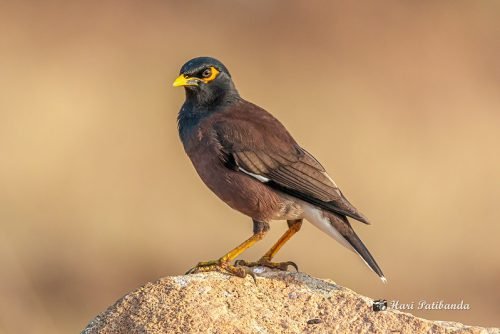
The Common Myna is primarily brown, but its head is black. The skin around its eyes is also yellow, and its bill and legs are yellow as well. When the bird is in flight, its white wing patches are very noticeable.
The Common Myna, or Indian Myna, is a species of starling also known as the Indian Mynah.
It is a true omnivore, eating anything from fruit to insects.
Its diet in the wild consists of various arthropods, crustaceans, mollusks, crustacean eggs, worms, snails, fruits, nectars, and grains. It is also known to scavenge and occasionally feed on bird eggs and chicks.
Common mynas may eat human food scraps, like discarded bread, fruit, and seeds, in urban areas.
It may be viewed from the northern part of the state to the southernmost point of the Florida Keys. Like other members of its family, the starlings, this brown and black bird is often found close to human habitation.
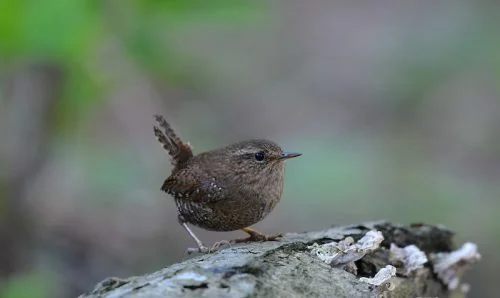
The Pacific Wren is a little bird with brown and rusty feathers and a long, narrow bill. Species like the Winter Wren and the Carolina Wren, to which it is closely related, are also part of the wren family, to which this one belongs.
The Pacific Wren is a true omnivore, feeding on both insects and small vertebrates. Insects, spiders, snails, and other minute invertebrates are their primary food source, and they find these by searching through the leaf litter and other debris on the forest floor.
Pacific Wrens live along the coast from Alaska to central California. They also live in the interior of a few western states. Some of Canada’s breeding birds travel only short distances southward each winter. Most often you’ll find them in temperate forests with lots of moisture and a lot of thick underbrush and flora.





